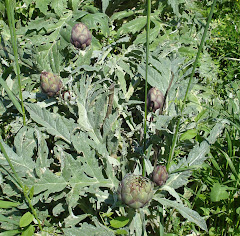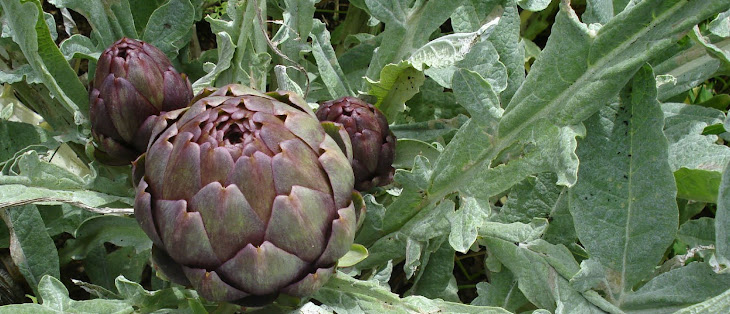Lo Jardinièr and I spend a lot of time talking about and eating local food. We try to eat food which is produced as locally as possible, and much of it comes from our own garden. We do try not to get obsessional about it, though, and Lo Jardinièr often points out that some trade between communities and between countries is essential. It's unrealistic to expect people in the twenty-first century to have the way of life which was common in rural areas during the nineteenth century. We've both read an interesting book by Gillian Tindall, Céléstine, about life in the Berry region of central France 150 years ago. Tindall discovered from letters written at the time that people in the village of Chassignolles very rarely went to the nearest town, La Châtre which was only 7 km away. The only things they needed to buy there were needles for sewing. Everything else was produced in the village. This kind of self-sufficiency is almost impossible to imagine now.
Nous essayons de manger la nourriture locale et beaucoup de légumes qu'on mange vient de notre jardin. Mais, le commerce est necessaire. En outre, vivre comme les gens du dix-neuvième siècle c'est peu réaliste. Nous venons de lire un histoire d'un village dans le Berry il y a 150 ans, Céléstine, de Gillian Tindall, qui raconte la vie du village de Chassignolles donc les habitants ont visité la ville de La Châtre très peu, seulement pour acheter les aiguilles. Tous leurs autres besoins étaient produit dans le village.
Kate at Hills and Plains Seedsavers has recently been writing about local food, too. With the eyes of someone new to French markets she has remarked on things which we sometimes take for granted, like the fact that almost everything you buy here is marked with its département of origin. In the markets here in the Languedoc very locally grown fruit and vegetables are marked 'pays', meaning the countryside around, or even the name of the village or small town near which they were grown, like the grapes from Clermont l'Hérault.
Kate a écrit sur le blog Hills and Plains Seedsavers au sujet de la nourriture locale. Une australienne en France, elle a remarqué des choses que nous ne remarquons plus, comme les départements d'origine de tous les produits qui sont indiqués sur les marchés.
Our aim is to eat mostly food which is produced within 100 km of Gabian, but to allow ourselves some foodstuffs, most importantly coffee, which come from further away. Sometimes during the winter I can't resist buying an aubergine which has come from the south of Spain and we eat citrus fruits from Valencia and dried fruit from north Africa, which I tell myself is almost local, just the other side of the Mediterranean. We've always eaten a lot of rice, occasionally Basmati rice from India, but since we've been living in Gabian mostly from Spain and Italy and the Camargue (about 100 km away), which I thought was the nearest rice production area. So I'm very excited to have found an even more local rice producer in Marseillette which is only 80 km away.
 |  Duo of red and white rice, cooked Duo of red and white rice, cooked |
Je suis ravie de trouver un producteur de riz qui est très proche - 80 km de Gabian à Marseillette dans l'Aude.
La Rizière de l'Etang de Marseillette
Laurent Malis grows long grain, red grain, round grain and whole grain rice in what was once a salt water lagoon which was drained at the beginning of the nineteenth century. His website has all the details (in French) of the area, the range of rice he grows and recipes. And, best of all, the rice is delicious!
Laurent Malis cultive le riz à Marseillette, sur un étang qui a été asseché en 1808. Le site Internet a des renseignements sur la gamme de riz, le terroir et des recettes. Et le riz est délicieux!
Lamb and aubergine casserole with rice / Casserole d'agneau et d'aubergine au riz
I made a casserole with some pieces of breast of lamb, onions, garlic, white wine, paprika and tomato passata. When it was nearly ready I added some reconstituted dried aubergine slices which we grew last summer, and served it with the Marseillette rice.
The recipe for this casserole will be on the Mediterranean cuisine blog. La recette sera sur le blog Mediterranean cuisine.
Tapenade
This was a very local dish. We made tapenade with some of the olives given to us in November by friends who live about 4 km away. We cured the olives and they are now ready to eat. You can add anchovies to tapenade, but this is a simpler recipe. We removed the stones from the olives, leaving about 300 gm of olive flesh. I chopped 3 cloves of garlic and some parsley in the food processor, added the olives and processed them, then added the juice of half a lemon, a couple of tablespoonfuls of olive oil and some salt. Et voilà! Serve the tapenade with lemon wedges and crusty bread or toast. These olives give it a lovely reddish colour.










3 comments:
I make something similar with bought olives (my olive tree has produced only pea sized fruit as expected!). It's also lovely toasted on bread.
Hi easygardener - tapenade tastes just as good with bought olives! And, yes, it's good on toast too. You're lucky to have any fruit at all on your olive tree. We had one in Wales and it did nothing at all! They do like a very dry climate.
Being obsessed with the quest for local sustainability (which is years away in my farming community), I define local as within 20 miles (35 or 40 KM). The key is that the waste returns to the local resource pool to be used by other (wild) community members and recycled back into humanly usable stuff. Closing that resource loop is the key to local.
Post a Comment